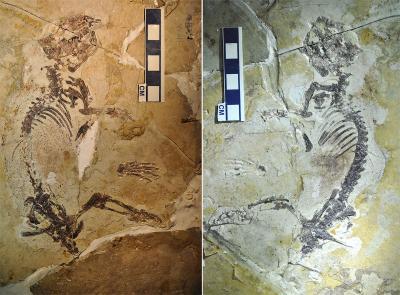A 160 million-year-old fossil of an extinct rodent-like creature from China has been identified as Rugosodon eurasiaticus and is helping to explain how multituberculates, the most evolutionarily successful and long-lived mammalian lineage in the fossil record, achieved their dominance.
Rugosodon eurasiaticus is currently the oldest ancestor in the multituberculate family tree. The nearly complete skeleton provides critical insights into the traits that helped such multituberculates thrive in their day. For example, the fossil reveals teeth that were adapted to gnawing plants and animals alike, as well as ankle joints that were highly adept at rotation.
In light of these findings, researchers suggest that R. eurasiaticus - what they call ‘Wrinkly Tooth’ - paved the way for later plant-eating and tree-dwelling mammals.
The multituberculates flourished during the Cretaceous era, which ended over 60 million years ago. Much like today's rodents, they filled an extremely wide variety of niches—below the ground, on the ground and in the trees—and this new fossil, which resembles a small rat or a chipmunk, possessed many of the adaptations that subsequent species came to rely upon, the researchers say.
"The later multituberculates of the Cretaceous [era] and the Paleocene [epoch] are extremely functionally diverse: Some could jump, some could burrow, others could climb trees and many more lived on the ground," explained Zhe-Xi Luo, a co-author of the Science report. "The tree-climbing multituberculates and the jumping multituberculates had the most interesting ankle bones, capable of 'hyper-back-rotation' of the hind feet."
"What is surprising about this discovery is that these ankle features were already present in Rugosodon—a land-dwelling mammal," he said. (Such highly mobile ankle joints are normally associated with the foot functions of animals that are exclusively tree-dwellers—those that navigate uneven surfaces.)

The fossil of Rugosodon eurasiaticus is preserved in two shale slabs in part (left) and counterpart (right). It is about 17 cm (6.5 inches) long from head to rump, and is estimated to have weighed 80 grams (about 2.8 ounces). The sediments at the site of discovery are lake sediments with embedded volcanic layers. The fossil assemblage of Rugosodon also includes feathered dinosaur Anchiornis and the pterosaur Darwinopterus. By the dental features, Rugosodon eurasiaticus closely resembles the teeth of some multituberculate mammals of the Late Jurassic of the Western Europe, suggesting that Europe and Asia had extensive mammal faunal inter-changes in the Jurassic. Photographed by Zhe-Xi Luo of University of Chicago and Chongxi Yuan of Chinese Academy of Geological Sciences
Additionally, R. eurasiaticus could eat many different types of food, according to the researchers. The fossil—particularly its dentition, which reveals teeth designed for shearing plant matter—confirms a 2012 analysis of tooth types that suggested multituberculates consumed an animal-dominated diet for much of their existence, later diversifying to a plant-dominated one.
Multituberculates arose in the Jurassic period and went extinct in the Oligocene epoch, occupying a diverse range of habitats for more than 100 million years before they were out-competed by more modern rodents. By the end of their run on the planet, multituberculates had evolved complex teeth that allowed them to enjoy vegetarian diets and unique locomotive skills that enabled them to traverse treetops. Both adaptations helped them to become dominant among their contemporaries.
The fossilized R. eurasiaticus that Yuan and his team unearthed was preserved in lake sediments, suggesting that the creature may have lived on the shores. However, the researchers say that the ankle joints of this early multituberculate were already highly mobile and its teeth were already oriented for an omnivorous diet. Based on their findings, the researchers suggest that such adaptations must have arisen very early in the evolution of the order, setting the stage for the major diversification of rodent-like mammals that ensued.
The discovery of R. eurasiaticus also extends the distribution of certain multituberculates from Europe to Asia during the Late Jurassic period, the researchers say.
"This new fossil from eastern China is very similar to the Late Jurassic fossil teeth of multituberculates from Portugal in western Europe," explained Dr. Luo. "This suggests that Rugosodon and its closely related multituberculates had a broad paleogreographic distribution and dispersals back-and-forth across the entire Eurasian continent."
Michael Balter at Science magazine writes, "Not only did Rugosodon have teeth that would have been very good at shearing plant material, but its ankles were also capable of rotating in wide angles, making it very agile. These features probably contributed to the more than 100-million-year-existence of multituberculates, a success story that ended only after true rodents independently arose about 60 million years ago and apparently outcompeted them to extinction."
Vol. 341 no. 6147 pp. 779-783 DOI: 10.1126/science.1237970






Comments